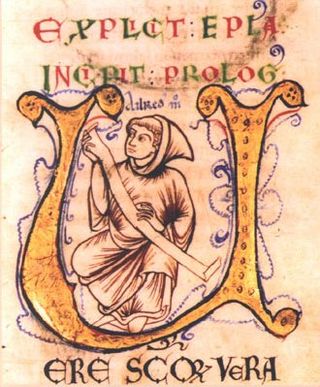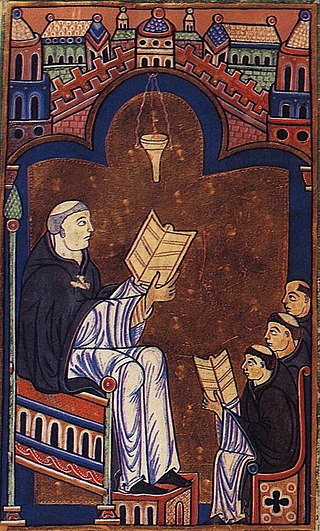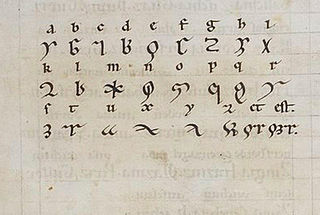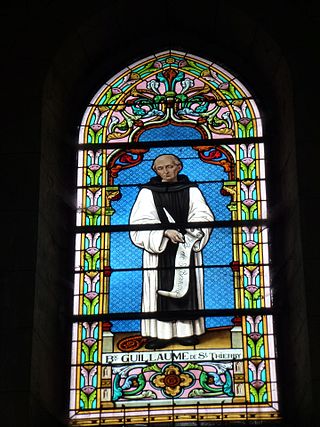Related Research Articles

Bernard of Clairvaux, O. Cist., venerated as Saint Bernard, was an abbot, mystic, co-founder of the Knights Templars, and a major leader in the reformation of the Benedictine Order through the nascent Cistercian Order.

Hildegard of Bingen, also known as Saint Hildegard and the Sibyl of the Rhine, was a German Benedictine abbess and polymath active as a writer, composer, philosopher, mystic, visionary, and as a medical writer and practitioner during the High Middle Ages. She is one of the best-known composers of sacred monophony, as well as the most recorded in modern history. She has been considered by scholars to be the founder of scientific natural history in Germany.

A sermon is a religious discourse or oration by a preacher, usually a member of clergy. Sermons address a scriptural, theological, or moral topic, usually expounding on a type of belief, law, or behavior within both past and present contexts. Elements of the sermon often include exposition, exhortation, and practical application. The act of delivering a sermon is called preaching. In secular usage, the word sermon may refer, often disparagingly, to a lecture on morals.

Aelred of Rievaulx ; also Ailred, Ælred, and Æthelred; was an English Cistercian monk, abbot of Rievaulx from 1147 until his death, and known as a writer. He is regarded by Anglicans and Catholics as a saint.

Hugh of Saint Victor, was a Saxon canon regular and a leading theologian and writer on mystical theology.

A lingua ignota was described by the 12th century abbess of Rupertsberg, St. Hildegard of Bingen, OSB, who apparently used it for mystical purposes. It consists of vocabulary with no known grammar; the only known text is individual words embedded in Latin. To write it, Hildegard used an alphabet of 23 letters denominated litterae ignotae.
Ordo Virtutum is an allegorical morality play, or sacred music drama, by Hildegard of Bingen, composed c. 1151, during the construction and relocation of her Abbey at Rupertsberg. It is the earliest morality play by more than a century, and the only medieval musical drama to survive with an attribution for both text and music.
Monastic sign languages have been used in Europe from at least the 10th century by Christian monks, and some, such as Cistercian and Trappist sign, are still in use today—not only in Europe, but also in Japan, China and the USA. Unlike deaf sign languages, they are better understood as forms of symbolic gestural communication rather than languages, and some writers have preferred to describe them as sign lexicons.

Thomas of Cantimpré was a Flemish Catholic medieval writer, preacher, theologian and a friar belonging to the Dominican Order. He is best known for his encyclopedic woek on nature De natura rerum, for the moral text Bonum universale de Apibus and for his hagiographical writings.

William of Saint-Thierry, O. Cist was a twelfth-century Benedictine, theologian and mystic from Liège who became abbot of Saint-Thierry in France, and later joined the Cistercian Order.
Helinand of Froidmont was a medieval poet, chronicler, and ecclesiastical writer.

Thomas Gallus of Vercelli, sometimes in early twentieth century texts called Thomas of St Victor, Thomas of Vercelli or Thomas Vercellensis, was a French theologian, a member of the School of St Victor. He is known for his commentaries on Pseudo-Dionysius and his ideas on affective theology. His elaborate mystical schemata influenced Bonaventure and The Cloud of Unknowing.

Scivias is an illustrated work by Hildegard von Bingen, completed in 1151 or 1152, describing 26 religious visions she experienced. It is the first of three works that she wrote describing her visions, the others being Liber vitae meritorum and De operatione Dei. The title comes from the Latin phrase Sci vias Domini. The book is illustrated by 35 miniature illustrations, more than that are included in her two later books of visions.
This is a bibliography of Hildegard of Bingen's works.
William of Luxi, O.P., also Guillelmus de Luxi or, was born in the region of Burgundy, France, sometime during the first quarter of the thirteenth century. He was a Dominican friar who became regent master of Theology at the University of Paris and a noted biblical exegete and preacher.
Geneviève Hasenohr is a French philologist and prolific scholar of medieval and Renaissance French literature. She has authored or contributed to more than forty books, written at least fifty academic articles and reviews, and prepared numerous scholarly editions.
Carolyn Anne Muessig holds the Chair of Christian Studies at the University of Calgary. A graduate of Fulton-Montgomery Community College, State University of New York at Buffalo, the University of Toronto, the Pontifical Institute of Mediaeval Studies, and the Université de Montréal, Muessig is a specialist in the history of medieval preaching, Jacques de Vitry, Francis of Assisi, Catherine of Siena and female educators of the Middle Ages. Prior to moving to Calgary, she was Professor of Medieval Studies at the University of Bristol. She was co-editor of Medieval Sermon Studies for 17 years and since 2001 she has been series co-editor with George Ferzoco of Routledge Studies in Medieval Religion and Culture.
Chrysogonus Waddell was an American Roman Catholic convert and theologian. A Trappist monk of the Abbey of Gethsemani, Kentucky, he was an accomplished organist, liturgist, historian, and a scholar of chant and Cistercian liturgy.
Wendy Mayer is an Australian scholar in late antiquity and religion who is a research professor and associate dean for research at Australian Lutheran College, dean of research strategy for the University of Divinity, and honorary research fellow at the University of South Africa. She is known for her work on John Chrysostom and on early Christian preaching.

De natura rerum is a thirteenth century work of natural history, written by Flemish Roman Catholic friar and medieval writer. Thomas of Cantimpré. De natura rerum may be Thomas' most significant work, as it's both the one he dedicated more time to and the one that had the largest posthumous fortune, as witnessed by the large number of codes that contain this work, but also by the many authors that took inspiration from it.
References
- ↑ Beverly Mayne Kienzle. edX. Retrieved 24 October 2015.